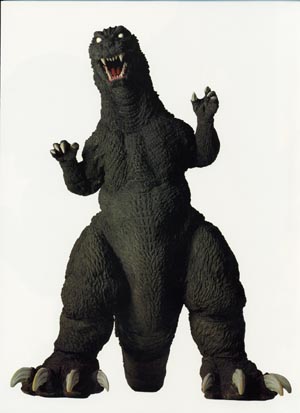
Stomp.
stompStomp.
stompstompStomp.
There goes Tokyo.
Godzilla has wrecked havoc for almost 50 years. In over 26 movies the
oversized radioactive dinosaur with really bad breath has destroyed most
major population centers in Japan as well as a few overseas targets. Over
this time, Godzilla has gained enormous popular support in Japan and a
strong cult following overseas. Godzilla has recently gained a higher
cultural status with entry, and that was not through the roof, into a
major art gallery. The exhibition, 'Since Godzilla', at the Taro Okamoto
Museum of Fine Art, is surely only the forerunner to the latex lizard
being declared a Living National Treasure.
The exhibition begins with a time setting display of art and artifacts.
As well as electrical goods of the 1950's, this includes a spectacular
painting by Taro Okamoto. It depicts a horrific incident, where a Japanese
fishing trawler, the Lucky Dragon, was caught in a cloud of radioactive
waste from a US nuclear weapons test which resulted in many deaths. The
event not only inspired Okamoto's painting but also was an important source
of inspiration for the Godzilla story.
Tomoyuki Tanaka, who died 1997 at age 86, was the creator of Godzilla.
He was also the producer of the first 22 Japanese Godzilla films over
a 41-year period. From its first appearance, as the result of nuclear
testing on US controlled Bikini Atoll, Godzilla has undergone various
transformations over the years from villain to super hero. In its celluloid
reign as king of monsters, Godzilla has also battled innumerable other
giant mutant creatures on earth as well as in outer space.
A large part of this series of film's popularity is their sci-fi "campy"
farce. A feature has been the 'man in the suit' style of special effect.
The exhibition includes four full sized Godzilla suits as well as an assortment
of other monster suits. Godzilla films have also always been noted for
the quality of their miniature work, particularly the accuracy of city
set constructions. The exhibition includes a full city diorama from the
Millennium Godzilla film. It depicts the monster (an actual suit) in battle
against a UFO, from the climactic end of the film.
There are also various film props such as an egg from Godzilla vs. Mothra,
1992, as well as Mothra's larvae form. The oxygen bomb, which once successfully
rid the world of Godzilla, is also on display along with an impressive
display of art produced for film posters. Actual scripts and original
storyboards by some of the epics noted directors, such as Ishiro Honda,
add to the artistic source material on display.
Since Godzilla's radioactive birth from nuclear weapons testing, the epics
have had a number of underlying serious themes. To stress these connections
the exhibition uses newspaper headlines and TV excerpts of events from
the era on display.
This documentary evidence reminds us of events such as the environmental
disaster of Minimata disease. Where it was found that a chemical plant
dumping waste into Minimata Bay resulted in people dying of mercury poisoning
from eating fish caught in the area. Spawned from these ecological disasters
was the 1971 production Godzilla versus the Smog Monster Ð Hedola. In
this movie, an outer-space germ feeds off the planet's pollution and industrial
waste. The 1962 Godzilla V's King Kong, which ends in a polite draw, is
a monster metaphor for the US/Japan security relations of the time and
the future fight for economic dominance. In other more recent movies,
a Robotic Godzilla rages rampant -- technology out of control. Yet, in
more recent films a robot is the savior from the beast. The exhibition
illustrates how the Godzilla series reflected the nation's fears and aspirations
over the last half-century.
Sited in the green oasis of Ikuta-Ryokuchi in Kawasaki city, the Taro
Okamoto Museum of Art is a spectacular museum. In the same park are the
Nihon Minka-en (Outdoor Folk Museum), Youth Nature Museum and remains
of Masukata Castle. The Godzilla exhibition, which is drawing good crowds
from across three generations, is a must for anyone who has enjoyed a
film from the series. However, the exhibition is also strongly recommended
for anyone interested in the art of Japanese popular culture or just curious
about the world outlook from this seemingly crazy, crowded island.
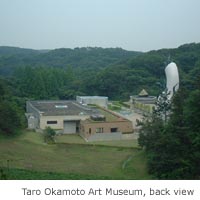

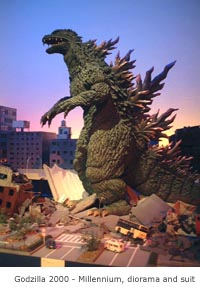
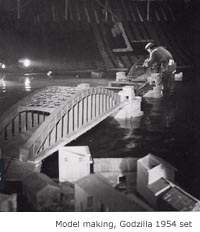
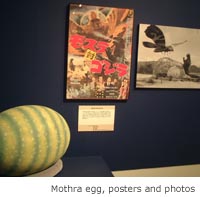
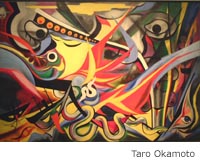
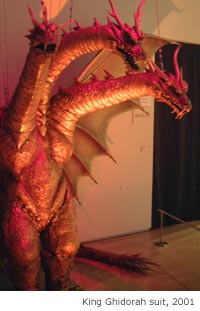
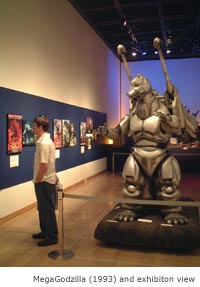
through July 28
Related events at the museum: June 6, 1:00 - 14:00 Discussion - Peter Mulsov, The US, the war and Godzilla followed by screening, Godzilla vs. Biollante June 16, 1:00 - 14:00 panel "What is Godzilla?" followed by screening, Godzilla '84 July 21, 1:00 - 14:00 Shusuke Kaneko (GMK director), "The Future of Godzilla". followed by screening of GMK: Daikaiju Soukougeki